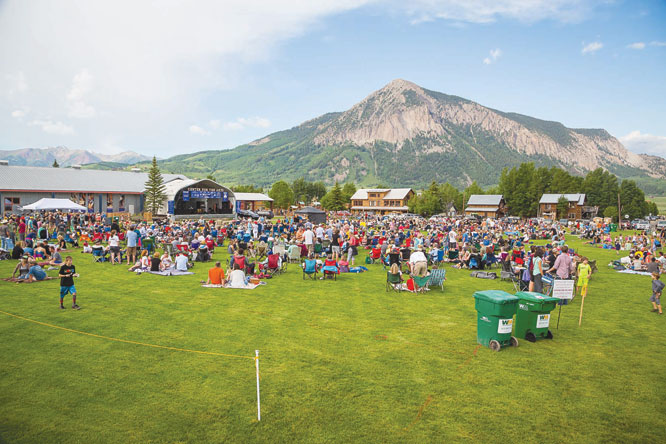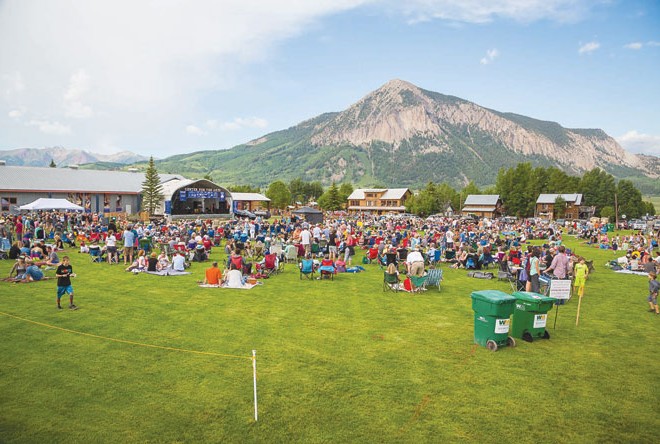Adding another layer of bureaucracy to Elk Avenue?
by Mark Reaman
A draft Creative District strategic plan took a few shots from the Crested Butte Town Council during a work session June 15.Developed over several months by town planner Michael Yerman with help from citizen and local “creatives” participating in a half-dozen public meetings, the introduction of the draft states the plan is meant to “inform decision making by the arts and creative community, a future Arts Commission, and Town Council. … The plan serves as a baseline to measure the future successes of the proposed district. It ensures the most effective use of resources to continue to meet the goals of the district.”
There is a still a two-year process to get the district officially certified by the state but several tasks must be completed before then.

A consultant, Amy Levek, has been hired to keep the project on track. She is being paid by the state through the Colorado Creative Industries. She helped set up the public meetings and gather the information for the strategic plan.
The Crested Butte Center for the Arts would be the anchor for the district that would encompass most of Elk Avenue and part of Belleview Avenue. It was estimated that current artistic and creative businesses contributed 39 percent of the total sales tax collected by the town in 2014. The hope is to grow that through the Creative District.
Melissa Mason of the local Arts Alliance outlined the plan for the council. The key goals in the draft plan include Community Engagement, District Characteristics, Economic, Social, Physical Characteristics, and Programming.
“Potential future projects are also identified in this plan for implementation in the coming years,” the draft states. “Key to the future implementation of this plan is the creation of an Arts Commission to serve as a quasi-governmental body to make recommendations to the Town Council on prioritizing and monitoring future projects in the district.”
Securing a future funding mechanism once grant funding from CCI ceases in 2017 will also be a priority according to the plan.
“The CCI is big on the term ‘Creatives’ because it includes more than fine artists,” Mason said. “It can include people like chefs, writers and metal workers, for example.”
As for the physical district itself, Yerman said the tighter the better. An Arts Commission could look for open spaces that could be filled with, for example, public art.
Mason agreed, saying, “The CCI wants it to feel like a real district with entrance and exit points and signage,”
But it was the idea of a future Arts Commission that concerned some on the council.
Will it change an already good Elk Avenue?
“To me we will have a tough sell,” said councilman Chris Ladoulis. “Does [a Creative District] dilute the specialness of Elk Avenue?”
“There was some discussion about not losing the look and feel of a quaint town by putting public art up at every street corner,” said Yerman.
“I could anticipate some tension between an Arts Commission and the BOZAR [Board of Zoning and Architectural Review],” said councilman Glenn Michel.
“They would be on two different paths,” explained Yerman. “It could be a commission with some decision making authority or something like the Cemetery Committee. You can tailor a commission to include a variety of people from different backgrounds including a BOZAR member.”
“Public art is always controversial,” said Ladoulis.
“Public art has certainly been a big topic,” admitted Yerman.
“We already have a lot of hands in the cookie jar when it comes to Elk Avenue and this adds another governing body overseeing Elk. It could complicate matters,” said Ladoulis. “Putting another overlay on Elk gives me concern. I don’t want tension from the arts. I want it all compatible.”
“The idea of public art, for example, is broad,” said Mason. “It doesn’t have to be in the Elk Avenue corridor. In fact, most of the original ideas I’ve heard about are outside of Elk.”
“When is too much too much? Is that what I’m hearing?” asked Yerman. “There could be, for example, one predetermined space for public art on Elk Avenue that changes pieces on a regular basis.”
Council needs final say
“I would say it still has to come back to the council,” said councilman Jim Schmidt. “What if Christo wants to put a blanket over Elk Avenue? Or someone wants to paint the street orange? The council’s job is to consider the big picture.”
“If you don’t empower a commission, is it then set up for failure with the CCI?” asked Ladoulis
“Right now the next big step is to get a strategic plan for our district,” said Yerman.
Councilman Roland Mason, Melissa’s husband, suggested the council receive more information on how other communities deal with Art Commissions, and especially with the idea of controversial pieces of art.
“The entirety of the commercial district is being viewed through an arts filter and as we have found, that sometimes doesn’t always mesh with the overall picture,” said Ladoulis, referring to last September’s Whatever USA event.
“It is the council’s job to rein in what happens,” reiterated Schmidt.
“The heart of the Creative District is empowering our community,” said Melissa Mason. “Getting creatives to work together to create cool projects. Our district might be less heavy-handed since we are already doing it in many ways. It’s about community support for arts.”
Yerman said it would be up the council to determine the best way to set up an Arts Commission. “Given how busy the council is, it could be beneficial to have a commission bring a recommendation for projects to the council. It would make the council job easier.”
Will it change an already good Crested Butte?
“What is bothering me is the institutionalizing of this,” said councilmember Skip Berkshire. “I like the organic feeling of art coming from Crested Butte.”
“The Mountain Express buses are a good example of that. We are apparently so desperate to become like every other place. And if that’s the attitude, we’ll lose it.
“We can promote our arts without an institution coming in to spread holy water on it,” Berkshire continued. “I’m troubled. I’d hate to see the arts become a bureaucracy that needs feeding and emulates other places. I really struggle with this. If we need to bring in the state to sanction what we do, I have a hard time with it.”
“Our creatives need help,” responded Melissa Mason. “They need money. The Creative District is not a top-down directive from the state. I feel it will be so Crested Butte-based on who has come to the public meetings. There isn’t a stamp or dictate from the state. The state has told us there are no rules. The arts are thriving here but we have hundreds of creatives who want a voice.”
“That’s the nature of life,” said Berkshire. “Not everyone can be an astronaut or hit home runs. Pretty soon it could create a situation where artists do whatever is needed to get their project through. I wish we’d try to do stuff on our own and be organic to Crested Butte. I don’t want to board a high-speed train to accommodate all the people. We’re a little, small town.”
“It is good to hear that point of view since the town will be on the hook for some money,” said Yerman. “We need to have that discussion.”
“The challenge of the plan is that there are 13 different arts organizations in the Arts Alliance,” said Ladoulis. “The first way to make art uncool is to get the government involved. So what is it we are really trying to solve? I don’t want to put another rope on Elk Avenue’s tug-of-war. What if the district is just three blocks of Belleview? No one is against the idea in spirit but there are a lot of questions that we [the council] need answered.”
“I think you both are overly concerned,” said Schmidt. “It will all be coming out of Crested Butte.”
The next step is for Yerman and the Arts Alliance to solicit general public input on the draft strategic plan and its direction. There will be a copy at the Crested Butte Old Rock Library and online. It will also be emailed to anyone who attended the planning meetings.
A new plan based on this summer’s public input will come before the council again in early August. “If the council adopts the plan through a resolution, then there will be two more years of funding from the CCI,” Yerman said.
 The Crested Butte News Serving the Gunnison Valley since 1999
The Crested Butte News Serving the Gunnison Valley since 1999



